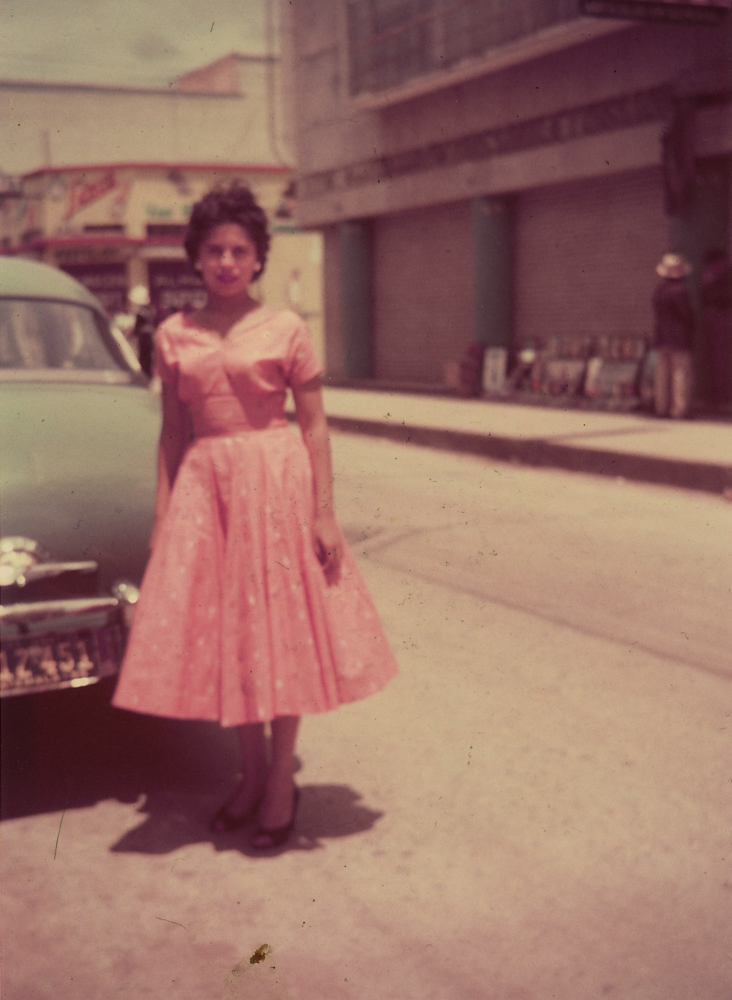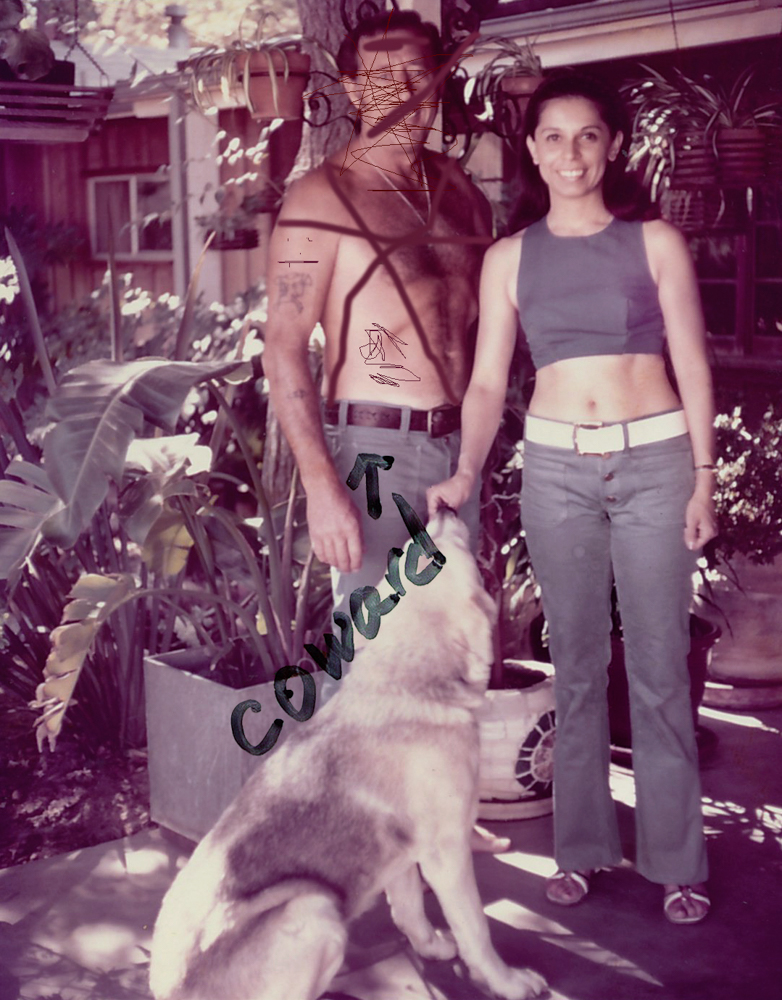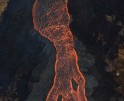The Foto Awards presented by Las Fotos Project: Hannah Kozak in Conversation with Aline Smithson
This week in honor of Latinx Heritage Month, we are celebrating a wonderful organization in Los Angeles: the Las Fotos Project and The Foto Awards event taking place on October 23, 2021. Today we begin the week with the Self- Expression Award Winner (adult), presented by Sony Alpha Female to Hannah Kozak for her project, He Threw the Last Punch Too Hard. The Self-Expression Award was created for bravery in creative expression or personal narratives in photography.
What goes on behind closed doors can often impact a family for life. Domestic violence is pervasive and insidious and those traumas seep deeply into all aspects of the every day. Kozak has spent the last decade creating work about violence that permeated her family and her life, and after ten years of focusing her camera and her emotions on her mother’s saga, she released a book under the same title published by FotoEvidence. An interview with Kozak follows.

Las Fotos Project’s mission is to elevate the voices of teenage girls through photography and mentoring, empowering them to channel their creativity for the benefit of themselves, their community and future careers. The organization was founded in 2010 to introduce teenage girls to the transformational power of photography and advance positive change in the surrounding community. Oftentimes girls and young women, and particularly many youth of color, experience marginalization that lead to feelings and recognition of powerlessness. Through photography education paired with mentors, 95% of which are women, Las Fotos Project provides a site for meaningful connection and reflection, where thoughts, feelings and questions can be voiced. The resulting storytelling and image making creates important ongoing validation of girls and women’s experiences.

As the organization approached its 10 year anniversary, the organization reflected on the images that students have created over the years, as well as the abundance of talent within the organization’s mentor community. From this reflection the organization realized that countless images created by women and non-binary photographers have shaped the way we see and experience the world, yet time and space dedicated to recognizing them are few and far between. And so, the staff set out to create this space in the same way they created space for young women. In 2019, The Foto Awards came to life with the focus to uplift the incredible contributions women and non-binary individuals make to the creative world. Mirroring the organization’s core programs, the celebration recognizes photographers in three categories: Self-expression, Advocacy, and Editorial. Each awardee, nominated by the public and selected by a team of the Foto Awards Host Committee and Las Fotos Project youth, personifies the spirit of Las Fotos Project’s mission to mentor teenage girls and gender-expansive youth by shattering industry expectations and molding new, inclusive narratives for future creatives.
The one-night-only event on October 23rd will not only shine a spotlight on artistic innovators, community advocates and entrepreneurs, but help Las Fotos Project raise the necessary funds to support its free programming for the 150+ youth of color they serve annually. The Foto Awards also features a silent auction of over 50 women and non-binary photographers from across the world. Each photographer has generously donated one of their images that the public can bid on and take home for their own personal collections.
Hannah Kozak was born to a Polish father and a Guatemalan mother in Los Angeles, California.
At the age of ten, she was given a Kodak Brownie camera by her father, Sol, a survivor of eight Nazi forced labor camps and began instinctively capturing images of dogs, flowers, family and friends that felt honest and real. As a teenager growing up in Los Angeles, Hannah would sneak onto movie lots and snap photos on the sets of Charlie’s Angels, Starsky and Hutch and Family, selling star images to movie magazines and discovering a world that was far from reality.
While working in a camera store at the age of twenty, Hannah’s life changed when she met a successful stuntwoman who became her mentor and helped her start a career in stunts. For over twenty-five years, Hannah’s work provided the opportunity to work with notable directors such as Michael Cimino, David Lynch, Mike Nichols, Tim Burton and Michael Bay. She worked as a stunt double for celebrated stars like Cher, Angelina Jolie, Lara Flynn Boyle and Isabella Rossellini. On every set, Hannah took her camera to work, capturing candid, behind-the-scene pictures that penetrated the illusion of Hollywood magic.
Her wanderlust and career in the film business afforded Hannah the opportunity to travel from Japan, Korea, Taiwan, Mexico, Guatemala and Peru to Egypt, Italy, Israel and India, capturing images of far away lands and exploring the innocence and truth found in the faces of children from around the world.
Hannah has turned the camera on herself, her life and her world. She continues to look for those things that feel honest and real, using her camera as a means of exploring feelings and emotions. After decades of standing in for someone else, she now is in control of her destiny and vision.
Hannah is an autobiographical photographer. Her subjects are the people and places that touch her emotionally. She has been photographing people and places for four decades. Photography has the power to heal and to help us through difficult periods, something Hannah Kozak knows first hand from personal experience. Follow Hannah on Instagram: @hannahkozak
He Threw the Last Punch Too Hard
When I was nine, my mother fell in love with another man and left our family. The man she left us for turned out to be violent: he beat her so badly that she suffered permanent brain damage and had to be moved into an assisted living facility at the age of forty one, where she still lives today. Of her five children, only my younger sister has visited her regularly over the years.
I have early, fond memories of my mother as a beautiful, passionate, vivacious, and fiery, Guatemalan Sophia Loren. But since she left, I have had tremendous feelings of abandonment and rage towards her. Her actions led me to judge her as an impetuous, selfish, reckless and negligent mother. I resented what she did to herself and to her family. I carried so much anger, yet whenever I saw her, I was overcome with pity and sadness. Just looking at her hand gnarled from the brain damage brought forth more emotion than I could bear. For these reasons, I have virtually ignored my mother in an attempt to distance myself from my own pain.
But pain ignored does not disappear and over time I came to realize our relationship needed healing. Thankfully, through graduate work in Spiritual Psychology and work I did with a healer, I was able to dissolve the judgments I carried about my mother and myself and begin to forge a relationship with her.
I feel our connection without fear as I create photos meant to take me out of my comfort zone. These photos tell my mother’s story of isolation, loneliness, abuse, connection, compassion, forgiveness, family, humanity, grace, joy and above all, love. I didn’t need to travel the world to deepen my spirituality. My greatest teacher was in front of me my entire life. I just couldn’t see it was my mother; a true Bodhisattva. She forgave me for not visiting her all those decades without uttering a word. I forgave her for leaving me and our family. Forgiveness happens when you care more about the love in a relationship than the logic of your ego. I no longer pity my mother. She continually inspires me teaching me to live by my heart, not my head. The love I feel for her has broken my heart wide open.
This is an ongoing project with the goal of bringing my mother back to Guatemala for the first time since she left fifty-three years ago. No one from her original family there has seen her since she moved, including a brother with whom she was once very close. Her only sister hasn’t seen her for more than fifteen years. I believe the story will continue to develop when I photograph her and her family in her homeland.
My mother has been living in an assisted living facility for more than thirty five years. A few months ago I asked my mother, “Que quieres”? “what would you like”? “Que todo la gente este bien.” Without hesitation she answered, “May all people be well.”
A few days ago I asked her a question I’ve asked of myself. ” que te gustaria, mas que nada en el mundo”? “What do you want more than anything in the whole world”? ” que todos nos queramos.” “That everyone love each other.” To which I whole-heartedly agree.
The elusive need, motive or tendency at the root of self-expression is truth. May these photos inspire someone else to leave an abusive relationship before it’s too late. – Hannah Kozak
Congratulations on your Las Fotos Award–so well deserved! Let’s start at the beginning. Can you tell us about the landscape of your childhood?
Thank you. I’m honored to have been chosen for the Las Fotos Award.
When I was nine, my mother left our family after falling in love with another man. From the ages of nine until fourteen, I witnessed that abuse on the weekends I spent with them. The man she left us for turned out to be violent; he beat her so badly that she suffered permanent brain damage. When I was fourteen, she went into intensive care at UCLA after one night when he went too far. My father then took care of my mother for six years, but when I was twenty it became too much for him, and he put her into assisted living. My mother has spent over half her life in two nursing homes.
Your long term project, He Threw the Last Punch Too Hard, is such a profound story that is deeply personal, yet universal. Did you have any idea where this project would go when you began documenting your mother?
The project began after I had an accident at work. I was a stunt woman and jumped out of a helicopter onto the tallest building in Downtown LA. I broke both feet. That injury force me inward and I realized I needed to heal my relationship with my mother. When I started, it just was my mother and me and my camera. I had no intention at the beginning of even showing the photos I was making to anyone. My camera brought me the separation and connection I needed. Very early, I realized there was something important happening there and I just kept going. I knew I had to publish a book of this work. But at that time, I didn’t realize I would photograph my mother for a decade. I led with my heart carrying intrinsic sadness over what happened to my mother.
Tell us how the project evolved, especially when it took shape as a book. Your use of ephemera and family photos makes it so much richer.
I was chosen by FotoEvidence as the inaugural “W” award 2019 (Woman). After a successful Kickstarter campaign brought to the finish line by one of my photography heroes, Douglas Kirkland, I began to work with my photo editor, Régina Monfort. Régina worked for Richard Avedon retouching prints for six years and maintained Irving Penn’s print archive. My edit of photographs from 10 years were laid on my hardwood floors and then went into my archives for ephemera and family photos. Together, the narrative presented itself to us with Régina’s expertise.
This past year, your book came out, you have won various awards, gotten tremendous press–what does it feel like to be on the other side of the tidal wave of recognition?
I didn’t create this project for recognition, I did it because my soul gave me no choice. If we don’t transform our pain, we transmit it. I wanted people to look at my mother’s story and see how letting go of judgment brought love. It’s nice it’s been well received because I was not going to stop until I told her story. A book is the product of human thought and I was told by a reader I never crossed a line into self-pity, preaching or shaking a fist. It’s gratifying that it’s been so well received because I was not going to stop until I told her story fairly and fully. The most important thing for me is to be using my voice for someone who doesn’t have one.
How does your mother feel about the book and the recognition of her journey?
My mother told me she liked the book. As far as recognition of her journey, my mother is a very quiet woman and she knows I like to make photos of her. I am proud of who she is: forgiving, loving, uncomplaining and the closest I person I know to a bodhisattva: always wanting the best for everyone but I wish she could know how she and her story have touched so many people.
Any personal take-aways from the project?
I like to believe that my higher power was the reason I broke both my feet and began to work on healing our relationship. In that respect, this project choose me. It’s truly a love story between a mother and daughter. The photos tell my mother’s story of isolation, loneliness, abuse, connection, compassion, forgiveness, family, humanity, grace, joy and above all, love. My mother and father are the bookends of my artistry.
What’s next for you?
What’s next is finding the right publisher for my project, Survivor: My Father’s Ghosts, where I retrace my father’s footsteps to the 8 forced labor camps he survived during the Holocaust. I traveled to Poland, Germany and the Czech Republic to 18 camps to fully flesh out my project while I was working on the project on my mother. I am also looking to publish Searching For Michael Jackson. I spent 10 years researching what the mass media did to Michael, also while working on the project on my mother and have created an unusual look at his Soldiers of Love. This book is an invitation to join my journey to set the record straight and honor Michael and cherish his legacy. I’ve been on the frontlines for ten years advocating for him even when it was not okay to stand up for him.
My mother is a symbol of perseverance. Even though she suffered permanent disability from domestic violence; she never lost her kindness, belief in love and hope. As my mother’s body deteriorated; her right hand turning in more, her soul flourished. What happened to my mother also fractured my persona yet we both grew from the trauma and she refused to be covered with a veil of pity. She is comfortable in silence and is fully present in the moment. I never planned to show these photos when I made them but I’ve learned that by sharing myself and my process of healing, that in turn helps others on their path to healing. The elusive need, motive or tendency at the root of self-expression is truth. May these photos inspire someone else to leave an abusive relationship before it’s too late and to show all is not lost no matter how hard we’ve been hit.
I started making photos when I was around twelve because I had to. Photography is how I navigated my world. Nothing has changed except I’m older and I have a nicer camera now.
Posts on Lenscratch may not be reproduced without the permission of the Lenscratch staff and the photographer.
Recommended
-
elin o’Hara slavick: Art + Science Competition Honorable MentionDecember 21st, 2024
-
Leslie Gleim: Art + Science Competition Honorable MentionDecember 20th, 2024
-
Zac Henderson: Art + Science Competition Third Place WinnerDecember 18th, 2024
-
Julie Anand & Damon Sauer: Art + Science Competition Second Place WinnersDecember 17th, 2024
-
Amanda Marchand and Leah Sobsey: Art + Science Competition First Place WinnersDecember 16th, 2024














































































